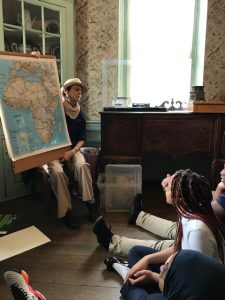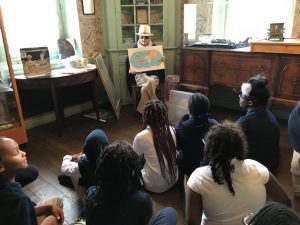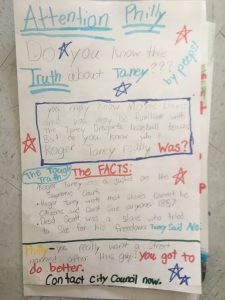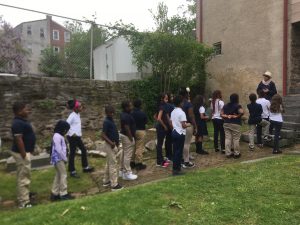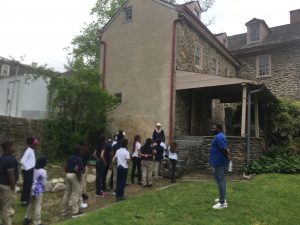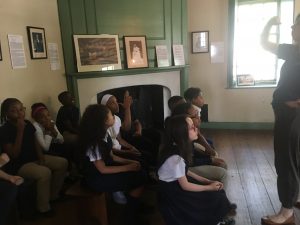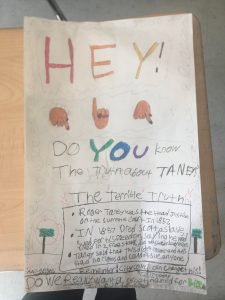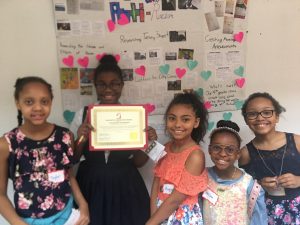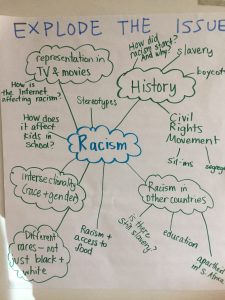Russell Byers 4th graders want to see change happen
What did they care about?
Developmentally, 4th graders are often fixated on the idea of fairness. They are passionate and outspoken when they perceive something in or outside the classroom to be unfair. Toward the beginning of the school year, Lucy Strother’s students participated in a lesson distinguishing equality (“everyone gets the same thing”) from equity (“everyone gets what they need”). This helped the students develop a more mature and nuanced definition of fairness, especially in the school context.
To kick off the Need in Deed discussions, the class considered “concentric circles” that displayed the various communities of which they are a part. They then began to highlight the strengths and challenges affecting each of those communities. It became clear that the students’ developing sense of justice was not limited to school issues. They were keenly aware of unfair treatment of marginalized groups – in Philly, nationwide, and globally!
After writing persuasive essays and debating several topics, the class reached consensus to explore the topic of racism. The conversations kept coming back to racism in America. Students were concerned about current events that reflected persistent racism. They considered their background knowledge about the history of slavery and the Civil Rights Movement. They wanted to know, “How did racism start? Why is it still happening? How do we get rid of it?”
What did the students learn?
The class began by building background knowledge about racism in the news. They read articles and considered how people of color are under-represented in movies and on TV. They completed a novel study of Maniac Magee, Jerry Spinelli’s iconic book about a homeless child who inadvertently helps two adjacent neighborhoods, segregated by race, overcome their tensions. The students discussed how Americans still live in largely segregated neighborhoods that limit their exposure to racial differences and keep stereotypes alive. Interestingly, this closer look at contemporary racism drove the students to become more interested in the history of racism. They read an article about the first documented law that was discriminatory by race, implemented in 15th-century Spain. Students learned that from the onset of American government, there has not been a level playing field for non-white people in America.
A visit from Waqar Rehman of the PA chapter of the ACLU helped students establish a strong working vocabulary for terms related to racism. They defined and practiced using words and phrases including “people of color,” “implicit bias,” “intersectionality,” “antiracism,” “stereotype,” and more. They also attended the “Jazz 4 Freedom” concert at the Kimmel Center, which taught students how African-American musical traditions have intersected with the history of racism and movements for social change.
The students were consistently curious to learn more about the history of slavery in particular. A study of Philadelphia’s role as a hub of abolitionist activity during the era of slavery was enhanced by an opportunity to visit the historic Johnson House in Germantown and dive into the histories of the Johnson Family, Henry “Box” Brown, William Still, the Grimke sisters, Harriet Tubman, Octavius Catto, and other abolitionists.
Finally, their research on slavery brought them back to present day Philadelphia when they read several articles from the Philadelphia Inquirer and Billy Penn about Taney Street. Students learned that Taney Street, located in Philadelphia’s Center City, has incited controversy due to its namesake, Roger Taney. Roger Taney was the Chief Justice on the Supreme Court in 1857, when an enslaved man named Dred Scott attempted to sue for his freedom. Roger Taney authored the infamous court decision that ruled slaves cannot be citizens and therefore have no legal rights whatsoever. Although there is no official documentation that the street was named for Taney, the street was named in 1858, just a year after the Dred Scott decision They found no other notable Taney for whom the street could have been named.
What did they do about the issue?
These 4th graders were incensed that there was a street in our city honoring the name of someone who perpetuated racism and supported slavery. The teacher was especially impressed when her 4th graders pointed out the irony of a city nicknamed “The City of Brotherly Love” having a street named for Taney. Students had an abundance of ideas for how to approach the issue. When they learned that City Council has the power to change street names through ordinances, students suggested writing letters. They sent letters to Councilmen Kenyatta Johnson and Darrell Clarke, whose districts contain Taney Street. They made informational posters and made loudspeaker announcements to teach our school community what they had learned about Taney Street. They even put together a quick video in the hopes of educating the greater Philadelphia community about Taney Street.
Within the school community, students got a lot of positive feedback and felt empowered that they had spread awareness of a little-known issue. Several adults in the school building stopped by the classroom to express their gratitude and share that they had no idea who Roger Taney was before hearing the morning announcements and reading the posters. Even though students have not received a response from City Council (yet!) we celebrate the way that these students helped educate so many fellow Philadelphians. And we look forward to seeing how they use their voice to make change as they grow up in this city.
